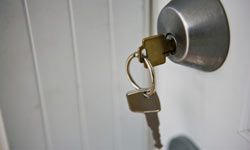Key Takeaways
- Reattaching a loose tile, reviving a dead battery terminal, silencing a squeaky floor, fixing a broken key and patching a holey screen are easy DIY repairs.
- Simple methods like using aluminum foil and an iron to reattach tiles or craft glue for squeaky floors make these tasks accessible without needing professional help.
- Techniques such as using super glue to fix a broken key or to patch up small holes in screens highlight innovative, cost-effective solutions that utilize common household items for repairs.
Over time, it's only natural that something in your house will need upkeep and/or repair; it's just one of the joys that comes with home ownership. But for many home items, you don't need to purchase expensive replacements that can cost you hundreds of dollars. Instead, take the DIY route, unleash your inner handyman and fix these five items yourself.
Doing small repairs around your home can save you tons of time and money, assuming you already have access to everything you'll need. Sure, everyone has their go-to home tool kit, but for these painless projects all you need is aluminum foil, a clothing iron and a little bit of glue. So save yourself an inconvenient trip to the hardware store, and look through these home fix-it tips to see how easy it is to whip your home back into tip-top shape.
Advertisement


